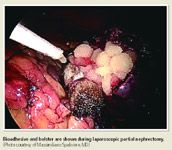Article
Sealant improves lap partial nephrectomy outcomes
Author(s):
Cleveland--A novel hemostatic sealant containing bovine-derived gelatin matrix and bovine-derived thrombin appears to be a useful adjunct for facilitating hemostasis and improving outcomes of laparoscopic partial nephrectomy, according to the results of a retrospective study from the Cleveland Clinic.
Cleveland-A novel hemostatic sealant containing bovine-derived gelatin matrix and bovine-derived thrombin appears to be a useful adjunct for facilitating hemostasis and improving outcomes of laparoscopic partial nephrectomy, according to the results of a retrospective study from the Cleveland Clinic.
In addition to assessing the benefits of the gelatin-based hemostatic agent (FloSeal, Baxter, Deerfield, IL), the researchers were interested in documenting the learning curve of laparoscopic partial nephrectomy. Using regression analysis techniques to control for covariates, they first compared outcomes in three cohorts of patients representing different subgroups in the cumulative laparoscopic partial nephrectomy experience of a single surgeon-Inderbir S. Gill, MD.

Fewer complications The results highlighted the fact that laparoscopic partial nephrectomy has a steep learning curve, but they also showed a benefit for using the gelatin-based bioadhesive with respect to decreasing blood loss and overall complications, particularly postoperative hemorrhagic complications.

"It seems reasonable to postulate as well that by minimizing hemorrhagic complications, use of this sealant translates into benefits of superior patient recovery and earlier ambulation with an accompanying decrease in the incidence of non-hemorrhagic postoperative complications."
The same basic laparoscopic partial nephrectomy technique was used in all study groups. The bioadhesive material was applied topically, layering the partial nephrectomy bed prior to bolster placement and conventional suture repair.
Comparisons involving the first 50 patients, cases 151 to 200, and cases 225 to 277 showed mean operative time was lowest in the first 50 cases (180 minutes) compared with the next two groups (225 and 210 minutes, respectively), as was mean hospital stay (2 days vs. 2.6 and 2.8 days, respectively).
More difficult cases Overall complication rates increased from group 1 to group 2 (24% vs. 38%) and fell with the introduction of the bioadhesive in group 3 (16%). The same pattern was seen in analyses of hemorrhage rates for the three study groups (8%, 20%, and 4%, respectively) and urine leak rates (2%, 8%, and 0%, respectively). Use of the bioadhesive also reduced estimated blood loss from 150 mL in both of the first two patient groups to 100 mL.
"It might be surprising that the operative time was longer and the complication rate higher among cases 151 to 200 compared with the initial 50 cases. However, with increasing experience, Dr. Gill now undertakes more difficult cases characterized by greater tumor depth into the parenchyma and closer proximity to the hilum," Dr. Spaliviero said.
Comparisons of the three groups further showed an increase in use of a transperitoneal approach and proportion with calyceal suture-repair. Between 64% and 72% of cases across the three groups were found to have renal cell carcinoma. Positive margins were found in three cases (6.4%) in the first series but in none of the latter two groups.















